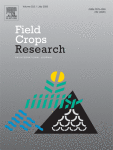Ver ítem
- xmlui.general.dspace_homeCentros Regionales y EEAsCentro Regional Entre RíosEEA ParanáArtículos científicosxmlui.ArtifactBrowser.ItemViewer.trail
- Inicio
- Centros Regionales y EEAs
- Centro Regional Entre Ríos
- EEA Paraná
- Artículos científicos
- Ver ítem
Crop nitrogen status of early- and late-sown maize at different plant densities
Resumen
In maize (Zea mays L.) crops, nitrogen (N) status at silking (R1) has been used to predict grain yield (GY) response to N fertilization and to develop strategies to manage crop nutrition in order to match N supply with crop demand during growing season, such as late N fertilizations. Crop N status can be estimated by N nutrition index (NNI), which is based on actual and critical N concentration in crop biomass. Optical measurements of N concentration
[ver mas...]
In maize (Zea mays L.) crops, nitrogen (N) status at silking (R1) has been used to predict grain yield (GY) response to N fertilization and to develop strategies to manage crop nutrition in order to match N supply with crop demand during growing season, such as late N fertilizations. Crop N status can be estimated by N nutrition index (NNI), which is based on actual and critical N concentration in crop biomass. Optical measurements of N concentration (e.g. SPAD readings) of the leaf blade subtending primary ear have also been used as a proxy of crop N status. Sowing date (SD) and N rates could affect soil N availability and hence crop N uptake at R1. Additionally, the effects of SD and its interaction with plant density (PD), N rates and hybrids (H) on N uptake (NuptP) and particularly on N partitioning in leaf-blades, stem + sheaths and ears could affect SPADs readings. We hypothesized that variations of GY by crop N status at R1 promoted by SD, PD and H, would be better predicted by NNI than by SPAD readings. In this study, two Hs (DK 70−10 VT3P and DK 73−10 VT3P) were cropped in two contrasting SD (early and late) in Paraná, Argentina (31°44′ S 60°32′ W) at three PD (5, 7 and 9 pl m−2) with three N rates (0, 90 and 270 kg N ha-1) in order to evaluate the effect of treatments on: i) N availability, N uptake at the plant and crop level, N partitioning in leaf-blades, stem + sheaths and ears, SPAD readings and NNI at R1, and ii) the relationships among N availability and N uptake at the plant and crop level, NNI, SPAD, and GY. N concentration of leaf-blades was negatively affected by PD, but this reduction was attenuated by N rates, especially in late SD (N x PD x SD interaction). Hence, in early SD, some data of both Hs corresponding to 270 N yielded low SPAD values for NNI greater than 0.86. Consequently, crop N status was better reflected by NNI than by SPAD readings, because NNI considers N stored in the whole plant. NNI at R1 adequately described relative GY variations promoted by SD, PD, N rates and, Hs, i.e. NNI was a more meaningful crop status index than SPAD readings. Overall, our study contributes to understanding mechanisms that regulate crop N status affected by agronomical practices and adds insights to explore in late N fertilization of maize crops.
[Cerrar]

Autor
Maltese, Nicolás;
Maddonni, Gustavo Angel;
Melchiori, Ricardo Jose;
Ferreyra, Juan Matías;
Caviglia, Octavio;
Fuente
Field Crops Research 258 : 107965 (November 2020)
Fecha
2020
Editorial
Elsevier
ISSN
0378-4290
1872-6852
1872-6852
Formato
pdf
Tipo de documento
artículo
Palabras Claves
Derechos de acceso
Restringido
 Excepto donde se diga explicitamente, este item se publica bajo la siguiente descripción: Creative Commons Attribution-NonCommercial-ShareAlike 2.5 Unported (CC BY-NC-SA 2.5)
Excepto donde se diga explicitamente, este item se publica bajo la siguiente descripción: Creative Commons Attribution-NonCommercial-ShareAlike 2.5 Unported (CC BY-NC-SA 2.5)

